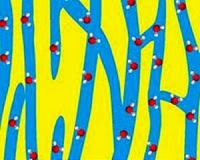Cars inch forward slowly in traffic jams, but molecules, when jammed up, can move extremely fast.
New research by Northwestern University researchers finds that water
molecules traveling through tiny carbon nanotube pipes do not flow
continuously but rather intermittently, like stop-and-go traffic, with
unexpected results.
“Previous molecular dynamics simulations suggested that water
molecules coursing through carbon nanotubes are evenly spaced and move
in lockstep with one another,” said Seth Lichter,
professor of mechanical engineering at Northwestern’s McCormick School
of Engineering and Applied Science. “But our model shows that they
actually move intermittently, enabling surprisingly high flow rates of
10 billion molecules per second or more.”
The research is described in an Editor’s Choice paper, “Solitons Transport Water through Narrow Carbon Nanotubes,” published January 27 in the journal Physical Review Letters.
The findings could resolve a quandary that has baffled fluid dynamics
experts for years. In 2005, researchers — working under the assumption
that water molecules move through channels in a constant stream — made a
surprising discovery: water in carbon nanotubes traveled 10,000 times
faster than predicted.
The phenomenon was attributed to a supposed smoothness of the carbon
nanotubes’ surface, but further investigation uncovered the
counterintuitive role of their inherently rough interior.
Lichter and post-doctoral researcher Thomas Sisan performed new
simulations with greater time resolution, revealing localized variations
in the distribution of water along the nanotube. The variations occur
where the water molecules do not line up perfectly with the spacing
between carbon atoms — creating regions in which the water molecules are
unstable and so propagate exceedingly easily and rapidly through the
nanotube.
Nanochannels are found in all of our cells, where they regulate fluid
flow across cell membranes. They also have promising industrial
applications for desalinating water. Using the newly discovered fluid
dynamics principles could enable other applications such as chemical
separations, carbon nanotube-powered batteries, and the fabrication of
quantum dots, nanocrystals with potential applications in electronics.
Source:
Northwestern University


No comments:
Post a Comment